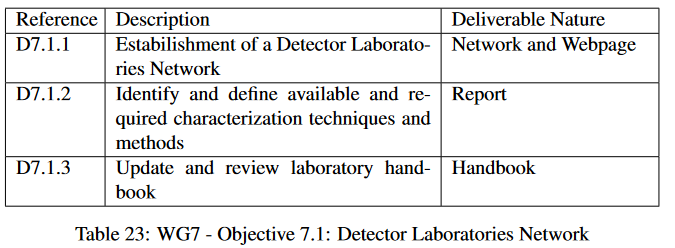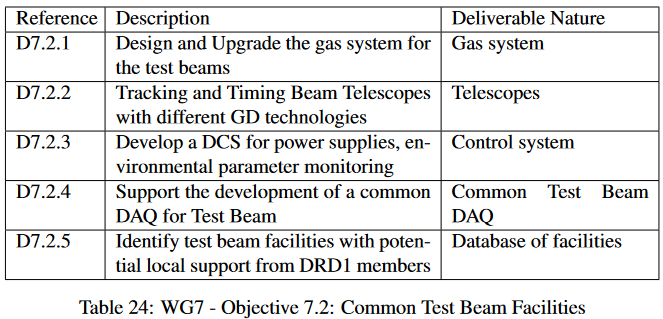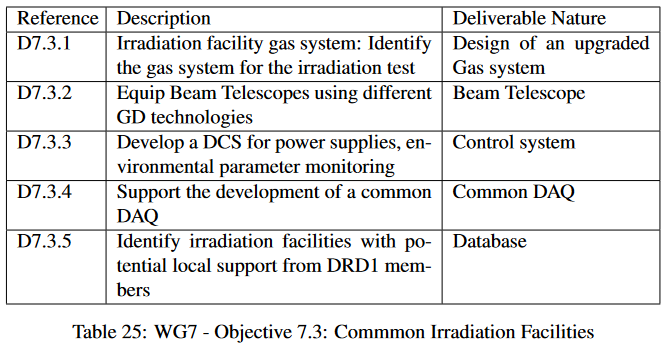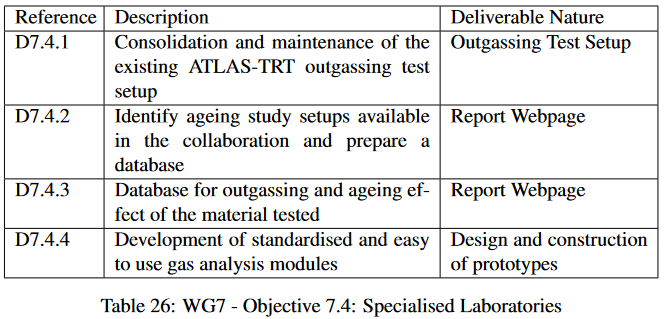Common test facilities
Contacts: K. Floethner, R. Guida, K. Kuznetsova, Y. Tsipolitis
Contact email: DRD1-WG7-convenors@cern.ch
Subscribe/Unsubscribe the WG7 egroup/mailing list: Subscribe/Unsubscribe
SPS Schedule: https://ps-sps-coordination.web.cern.ch/
TEST BEAM CAMPAIGNS
DRD1 September 18 - October 10 Test Beam Campaign :Link
DRD1 June 26 - July 10 Test Beam Campaign: Link
DRD1 April 10-24 Test Beam Campaign: Link
NEWS:
EURO-LABS (Supports to facilities and to access facilities): Link
DETECTOR LABORATORIES NETWORK
We propose the establishment of a strategic worldwide distributed network of research laboratories to meet the needs of the scientific community. The network would serve as an entry point for the community, providing support and disseminating methodology and instrumentation to facilitate the work of detector scientists. The laboratories in the network would work collaboratively to share expertise, resulting in greater efficiency and cost-effectiveness. The development of this network would also help to increase the value of the laboratories at the national level, showcasing their contributions to cutting-edge research and innovation.

Network Establishment: The goal of this task is to establish a network of laboratories that can support the scientific community in conducting detector characterization studies, providing access to specialised instrumentation and test setups that might otherwise be difficult to obtain. The task will involve identifying potential laboratories and evaluating their capabilities and resources. Required agreements and protocols for accepting groups will be specified.

Characterization Methods and Techniques: The second task of this proposal is to discern techniques and methods for detector characterization. Existing solutions will be spread in the community and new ones introduced when required. The task will cover the development and dissemination of appropriate instrumentation, including sensors, electronics, and data acquisition systems, to support detector studies. Collaboration with industrial partners will be pursued for technological and dissemination aspects.This task will be carried on in synergy with WG8 Training and Dissemination Initiatives.
Laboratory Handbook: The third task of this proposal is to keep up-to-date an open-access laboratory handbook. The handbook will serve as a comprehensive resource for the network of laboratories, providing detailed documentation on techniques, methods, instrumentation, and other relevant topics. The The Gaseous Detectors Handbook by F. Sauli will be used. The task will involve reviewing and updating the handbook on a regular basis to ensure that it remains cutting-edge and relevant to the needs of the scientific community. This task will be carried on in synergy with WG6 (D6.4.1) and WG8 Training and Dissemination Initiatives.

COMMON TEST BEAMS
Measurements in test beam facilities cover all the critical performance parameters for new detector systems like efficiency, noise, time/position/energy resolutions etc. As members of the DRD1 collaboration, research groups will get easier access to the test beams and irradiation facilities by making common requests and grouping the test campaigns. The main test beam facility will be at CERN's North Area SPS extraction lines but the possibility of using other test beam facilities will also be explored. The collaboration will develop common infrastructures (including gas systems), DAQ/controls, as well as test beam analysis software that can easily integrate additional detector systems (ref. to objective 5). It will serve as a vehicle for community building and will address individual component performance, as well as combined performance and integration issues whenever appropriate.
Common Test Beam at the CERN SPS/NA: CERN’s PS and SPS can provide a variety of particle species with a wide momentum range. The collaboration plans to request common test beam time periods at the SPS. The H4/PPE134 experimental area in EHN1 is identified as the best location given the available beams, the space and the presence of a 1.5T Magnet with a large enough opening. The area has been used in the past by the RD51 Collaboration for regular common test beam campaigns.
Tracking and Timing Telescopes: Based on different (gaseous) detector technologies, the collaboration is aiming to build tracking and timing telescopes that can be made available for collaborators coming to the common test beam. Though remote support will not be provided, the hardware can be shared to be used outside of the common test beam campaigns at the SPS/NA.
Common DAQ(s) and Software: The DAQ software developed in the context of common electronics will be made available to the community. A repository of analysis software will be created to allow the exchange of developments between groups. As such, existing analysis framework repositories as REST-for-Physics could be potentially explored.
Identify Other Test Beam Facilities: The aim of this task is to identify other test beam facilities that have a local support group that could be accessed by members of the collaboration. This way DRD1 collaborators may have alternative testing sites: (i) for periods that CERN beam facilities are not available (e.g. periods of long shutdowns) or (ii) in case of difficulty to bring their equipment to CERN and therefore prefer a local test beam site.

IRRADIATION FACILITIES
The DRD1 irradiation program will focus on using available facilities to optimize the development and selection of the most suitable radiation hard technologies for the various gaseous detector components and, at a later stage, assess and monitor the radiation hardness of the qualified components during production. Moreover, the characterization of specific detectors designed for prolonged operation under a large particle background requires targeted ageing tests. Research groups will get easier access to irradiation facilities by making common requests for facility space and irradiation time. The Gamma Irradiation Facility (GIF++) at CERN is a natural choice since it is already structured to host different research teams. The possibility of accessing other facilities that are available in the community will be investigated and the requirements to be fulfilled for shared use (i.e. hardware, software, and/or management upgrades) will be identified.
Define requirements and potential strategies: We will assess how irradiation facilities can meet the requirements of the DRD1 community in terms of available space, irradiation time and dose, etc. To this end, we will need a detailed understanding of these requirements on the “user” side to ascertain if current facilities are “strong” and “large” enough: otherwise, we will have to foresee interventions.
Common Irradiations at GIF++: CERN GIF++ is a large irradiation facility equipped with a 12 TBq Cs-137 source, providing 662 keV gammas over a large volume and a 150 GeV muon beam. Planning tools should be devised and implemented to facilitate finding the most suitable spatial and temporal slots to fulfill teams' requirements for availability, time, particles, radiation dose, and services.
Common gas systems, electronics, and software: Sharing of facilities and test results would be greatly simplified with the adoption of common and easily maintainable electronics, gas systems, and DAQ systems. A preliminary assessment of the research groups' requirements will be needed to understand the feasibility and usefulness of standardization and the eventual need for custom developments of existing tools.
Beam and cosmic triggers: Some irradiation facilities (GIF++ included) can be coupled with particle beams. In this respect, an increased effort is warranted to implement a common beam trigger device, complete with detectors and customizable logic. Moreover, the aging activities would benefit from a large area cosmic ray telescope which could continuously monitor efficiency and other performance parameters in periods when the muon beam is not available.

SPECIALISED LABORATORIES
This activity is strongly connected to the WG3 research lines (Sec. WG3). It is intended to supply the collaboration with the tools used for the research, give value to local realities for global purposes (as well as valorize each interested laboratory at the national level), and identify possibilities (with in-kind contributions from local support).
Outgassing and Ageing Laboratories: Any permanent or semi-permanent degradation of detector performance is classified as an ageing effect. The first check to be performed when a material/component is used for the assembly of a gaseous detector is to certify its compatibility with the gas mixture. Indeed, the use of new material/components can bring into the gas mixture unwanted volatile chemical species that can poison the gas mixture and finally compromise the detector's performance. This check should be applied to all materials that will be in contact with the gas mixture. The ATLAS-TRT team developed a setup used to check the outgassing from materials or equipment. This setup is still used by them and by the CERN EP-DT Gas Team to certify any component used for the gas systems built at CERN. Other similar setups exist in the collaboration, they will be identified and classified.
Gas Analyzers: The gas mixture is the sensitive media where the detectable signal is produced. A correct and stable mixture composition is a basic requirement for good and stable long-term operation of any gaseous detectors. The presence of contaminants or a wrong composition not only can affect the immediate performance of a detector but can potentially accelerate ageing processes. The development of standardized and easy-to-use gas analysis modules is of paramount importance for the understanding of detector performance and, finally, detector test results. Typical impurities that indicate that the mixture is not under control are O2 and H2O.
For monitoring the concentration of the main mixture components or the presence of other impurities, a gas chromatograph station is needed.
For material (detector and infrastructures) studies, other analyzers are available in the collaboration and a common effort will be done to classify them into a shared database.

INSTRUMENTATION AND SOFTWARE SHARING
The scope of this objective is the dissemination of tools and instrumentation in order to offer the possibility to the groups to share their developments. For this objective, we set the following tasks:
Gas Mixture Supply Systems and Monitoring Tools: It has been demonstrated by the experience accumulated during the preparation and operation of the gas systems for the CERN LHC experiments, that the definition of standard modules can facilitate the construction, operation, and maintenance of the gas systems.
Moreover, the design and the resulting use of standardized gas modules can facilitate the characterization of gaseous detectors.
The controls software for the gas system can run either locally on a standard PC or, for more complex installation, in a PLC. The user interface will make use of standard software provided by the suppliers or WinCC-OA applications in the case of more complex systems.
Laboratory Instrumentation: Standard laboratory instrumentation is important to facilitate the work of experimental groups in detector characterization both with cosmic rays and particle beams. Although some of these instruments may be dependent on the kind of detector technology under test, nevertheless, most instruments are general purpose and can be shared by different groups at different times. Therefore, we aim to establish a common store of standard equipment for remote detector control, readout electronics, data acquisition based on NIM, VME and standard high-voltage supply equipment. We intend to compile an online catalog of available modules at the various common DRD1 infrastructure locations and also facilitate the search and the possible rent of additional equipment at the CERN store. This should be extended also to non-standard and custom equipment available at various sites so that in case of particular needs, a group could first address the request to the community before embarking on new developments. In parallel, we aim to form a group of experts who could help newcomers with the correct use of the equipment and/or the understanding of possible failures.
Laboratory and Test Beam Software: Software infrastructure is more dependent than hardware on detector technology and front-end electronics. However many tasks are common and could be standardised with only minor modifications for different detector types.
There exist software efforts in the community, such as REST-for-Physics , leading towards common detector data processing using a unified data format for the different stages of detector event processing, such as detector response, event reconstruction, waveform analysis, etc. The unified data format provided by REST-for-Physics links appropriately between detector data processing and analysis, simulation packages and electronic readouts. The community plans to explore the potential use of and contribution to the software readily available. Software for remote detector control, data acquisition, HV and gas system monitor/control are general-purpose libraries that can be of common use. We propose to develop and maintain these common libraries producing also the corresponding documentation. A proper repository with updated libraries and manuals will be available and a TWiki page will be updated with all the important information. Again we would like to make available a group of experts for problem-solving in case of software failure. As for the hardware infrastructure, custom software libraries that have been developed for special purposes will also be included in the repository.

Detector Test Facilities Databases
An updated list of facilities that are available for detector tests will be created. It will cover test beams, irradiation, and other useful specific measurements.
http://irradiation-facilities.web.cern.ch/